Hindu famous (authentic) (sacred) pilgrimage sites in India – Part 3
Namaste friends, how are you doing today? Welcome to #BhagavanBhakthi website / blog.
Bhagavan Lord Sri Krishna blessings to you and your family!
In this website / blog, you will always learn about #Hinduism #Sanskrit language.
Also subscribe to my YouTube channel from this link #BhagavanBhakthi to view videos about #Hinduism #Sanskrit language.
Just before moving towards to know about “Hindu famous (authentic) (sacred) pilgrimage sites in India – Part 3“, let us know few basic information.
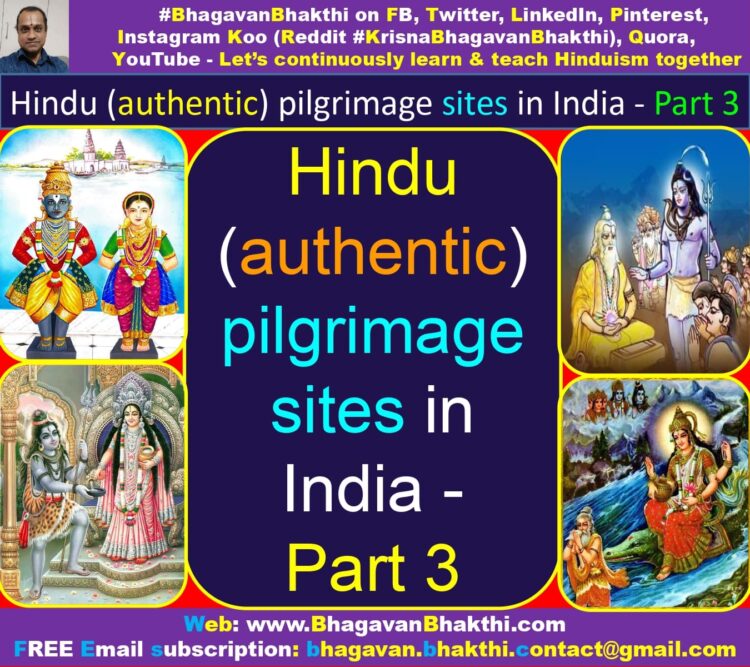
I urge to the readers to read this post completely and also to read the other posts connected with this post, to understand about all the pilgrimage sites of India with authenticity as per Hindu Puranas.
Note : Please note that, as said in the part 1 and part 2, this below information is based on an authentic grantha (Hindu text) which was written around 500 years ago.
And this is completely free from the today’s Babas, Swamy’s, modern temples, money oriented temples, etc. information.
For few web visitors, these pilgrimage places may look like unknown places.
But, all these places are genuine pilgrimages places as given in Hindu Puranas and other granthas (texts).
There was a great and divine saint (Sanyasi) in Udupi, in South India called as Guru Sri Vadiraja Tirtha nearly 500 years ago.
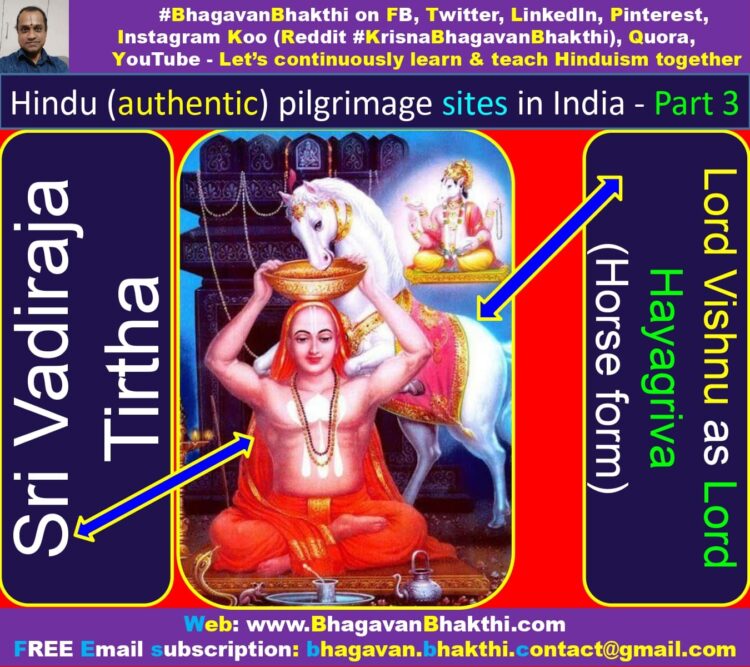
He had travelled all over India and had written a grantha (Hindu text) called as ‘Tirtha Prabandha‘ (pilgrimage places information).
In this grantha (Hindu text), he has given information about the various pilgrimage places around the India.
Guru Sri Vadiraja Tirtha visited the holy pilgrimage sites around India starting from Udupi (Karnataka) in a clockwise direction, through:
West —> North —> East —> Southern directions.
Finally Guru Sri Vadiraja Tirtha reached a place called today’s Thiruvananthapuram and submitted his holy grantha (Hindu text) at the lotus feet of Lord Sri Ananthapadmanabha Swamy in Kerala.
Now, let us know those pilgrimage places basic information.
Let us continue from “Hindu (authentic) pilgrimage sites in India – Part 1, Part 2“, that is, let us start from the Uttara (Northern) side from where we left in Part 2 as given below:
Uttara Prabanda (India’s Northern side pilgrimage places part 3 information) is as given below:
(This covers west-northern parts of the authentic pilgrimage places of India)
Krishnaveni river : The river originates from ‘Mahabaleshwara’ (Mahabaleshwar) 120 kms from Pune.
Bhima river and Tunga-Bhadra river joins Krishna river towards their flow and joins today’s Bay of Bengal near Vijayawada (Andhra Pradesh).
Krishnaveni is a confluence of two rivers Krishna river and Veni (Venna) river.
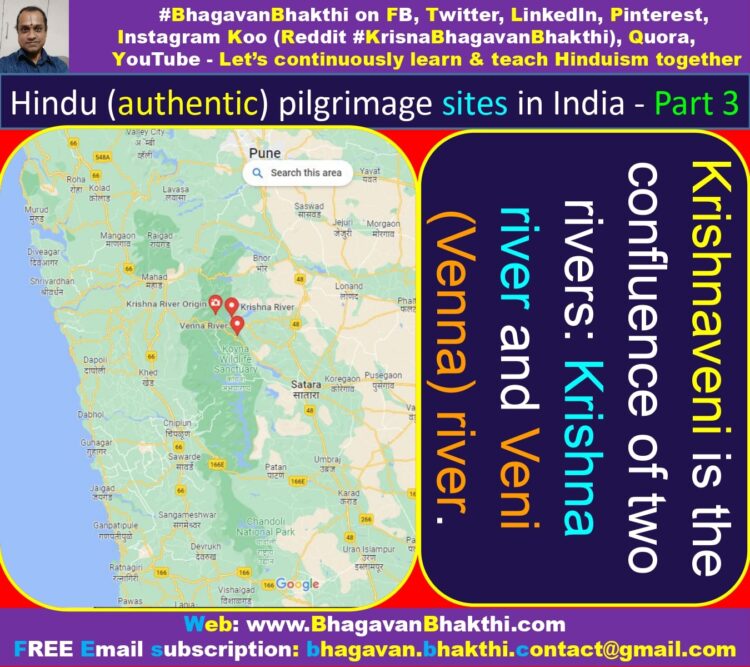
It is one of the mahanadis (great rivers) of India.
गुरुं कन्यागतं धन्या या पुरस्कृत्य सेव्यसे | श्रीकृष्णवेणि पापानि सा त्वं पुण्ययसि ध्रुवम् ||
Meaning of the above shloka : O Krishnaveni river! you are definitely blessed!
You, when worshipped under the headship of Guru Brihaspati (Devatas Guru), convert Paapa (bad deeds) into Punya (Good deeds). This is certain!
Note : When Guru Graha (Jupiter planet) enters Kanya Rashi, worshipping river Krishnaveni and taking bath in it is very auspicious.
The same is being highlighted here by Guru Sri Vadiraja Tirtha.
Hindu Shastras says that, when such a ritual is being observed, sage Brishaspati (Guru of Devatas) and others must first be offered Arghya and other Upacharas.
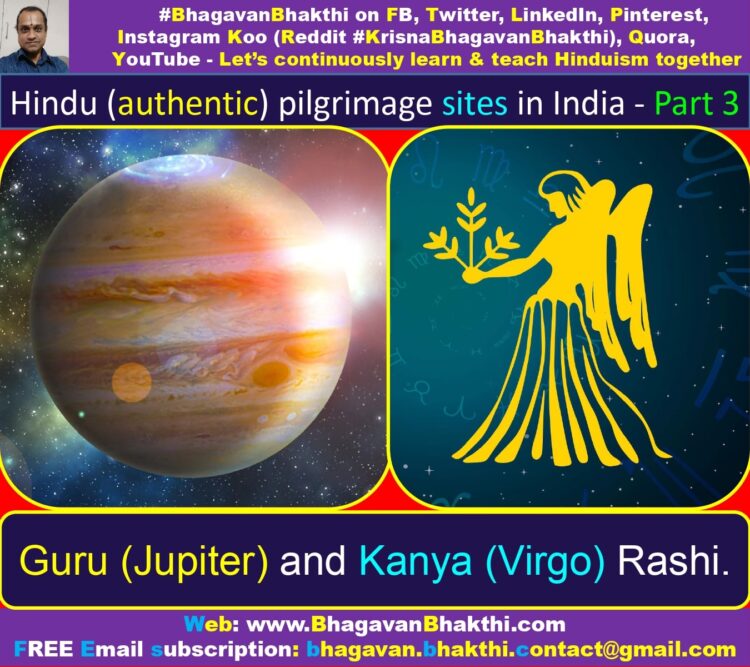
When Guru (Planet Jupiter) enters Kanya Rashi, Holy Ganges along with 33 crores of Tirthas (Divine rivers) are present in this one river Krishna (Krishnaveni).
Pandharapura (Pandharpur) Kshetra : It is around 60 kms from today’s Sholapur district in Maharashtra.
Bhima river flows in this divine place of Pandharpur and this river is also called as ‘Chandra Bhaga‘ (Chandra Bhag) river.
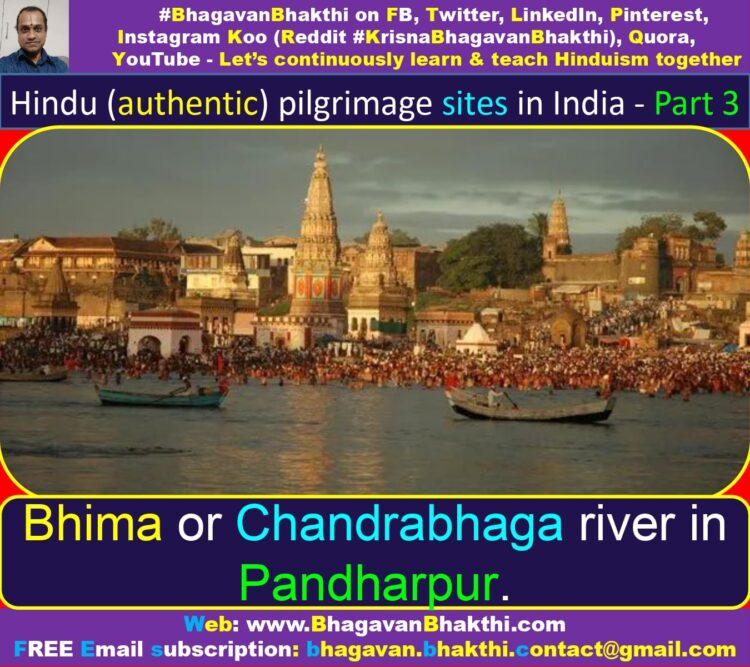
Here Lord Panduranga (Lord Krishna / Vishnu) appeared here to bless hid devotee Pundarika (Who loved and worshipped his parents with utmost devotion and dedication).
Upon the request of Pundarika, Lord Panduranga (Lord Krishna / Vishnu) appeared to stay here forever.
Many Sri Hari devotees visit Lord Vitthala (Vitthal) (Panduranga) and composed multiple divine songs on Panduranga / Vithoba / Vitthal.
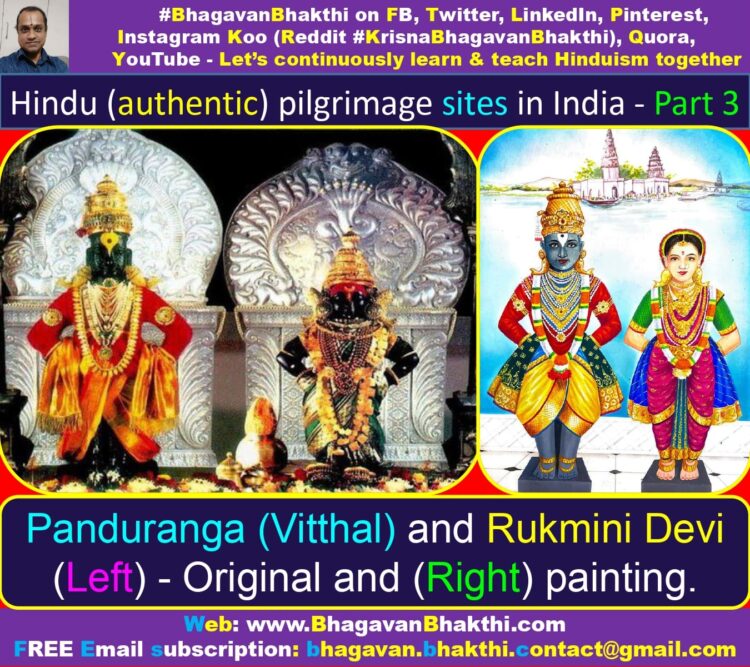
Godavari river : This holy river originates from Trimbak hill (Trimbakeshwar / Tryambakēśvara).
(In Sanskrit it is called as Trayambaka). It is 25 kms away from Nasik (Nashik) station.
This river merges with today’s Bay of Bengal near Rajamundry travelling a distance of 1500 kms.
When Guru Graha (Jupiter planet) enters Simha Rashi, Holy Ganges along with 33 crores of Tirthas (rivers) are present in this one river.
Godavari is one of the ‘Sapta Mahanadis’ (Seven great rivers) of India.
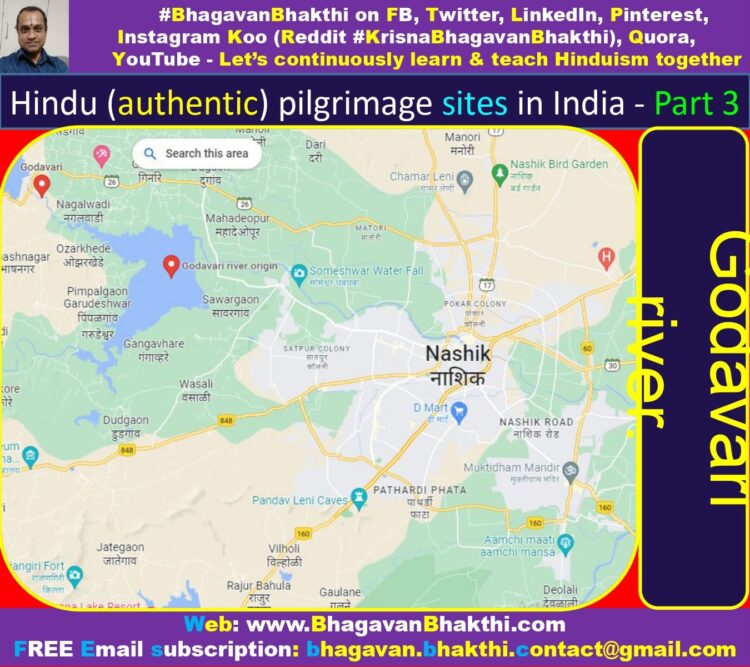
Amongst the hierarchy of rivers, Godavari comes second after Ganga river.
Maharishi Gautama was once convinced by some other Rishis that he killed a cow.
Maharishi Gautama then performed a penance to Lord Shiva and as boon asked for Ganga water.
Maharishi Gautama poured the same river’s water on the body of the cow, causing it to come back to life.
That small puddle of water flowed as river Godavari.
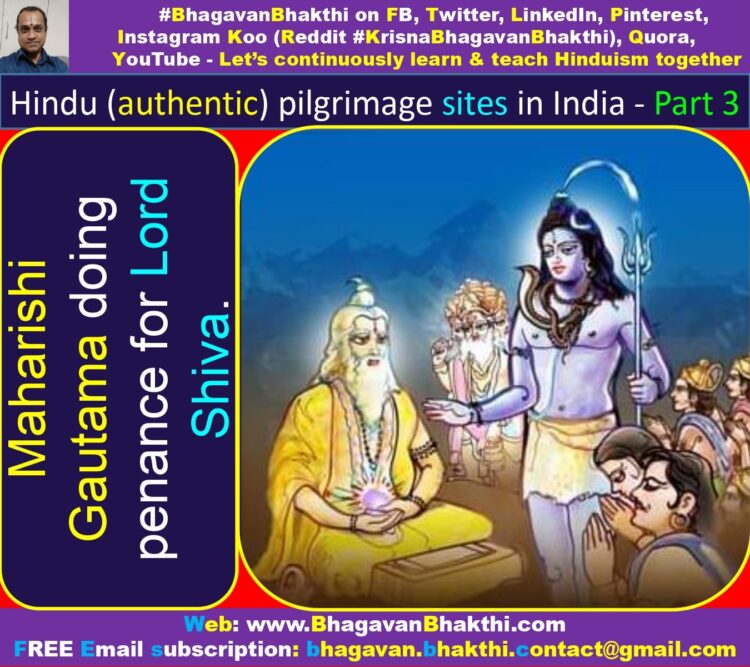
Yamuna river : This revered river’s origin is 10,000 Ft above sea level at the point known as ‘Yamunotri’ (Also called as Yamunadri) in Himalayan mountains.
Usually the water of this river will be very cold. Yamuna river is also known as ‘Kalindi‘.
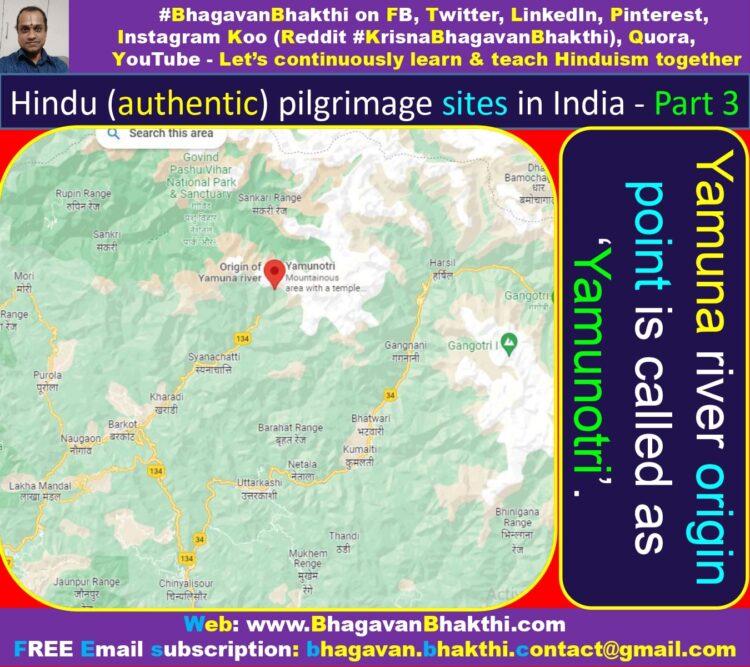
Yamuna joins Holy Ganges at Prayagraj (Prayaga).
Guru Sri Vadiraja Tirtha explains that, Yamuna never sends anyone who worship her to Yama Loka (Death place),
but instead she sends the good atmas (souls) directly to Vaikuntha Loka.
Harivamsha (Harivansh) narrates that Yamuna and Lord Yama Deva were born as twins to Lord Surya Deva and Sanjna Devi.
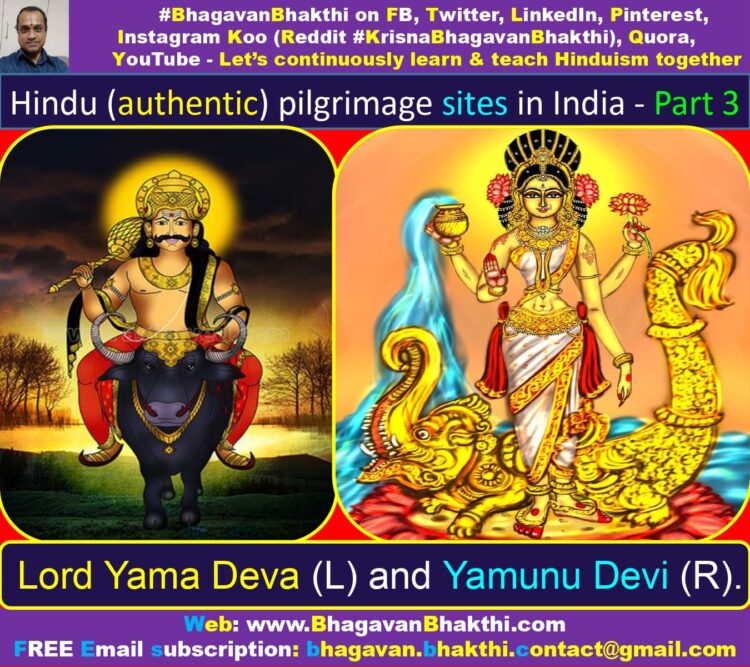
Triveni Sangam : Those who take a holy tip at the merging point of Ganga, Yamuna and Saraswati,
gets deliberated from rebirth, that is, that person will get moksha / mukti (A direct place at Vaikuntha).
The confluence of these three rivers, that is, Ganga, Yamuna and Saraswati is known as Triveni Sangam.
In this place, there is a ‘Vata Vriksha’ (Vat Vriksh) which can wipe away all our sins.
During ‘Pralaya Kala‘, Lord Vishnu rests in this same place of Triveni Sangam.
The great and huge ‘Kumbha Mela‘ is held here in this place once in 12 years.
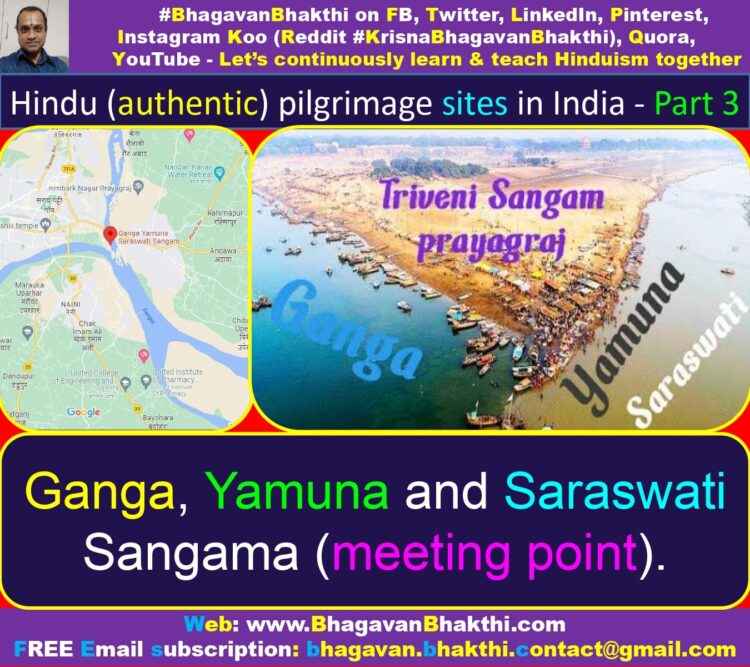
Prayag Madhav (Prayaga Madhava) : Lord Brahma performed a yagna during the period of creation after Pralaya.
The mahabharata documents that brahma performed a yaaga at this place.
Hence the place derived the name prayaaga.
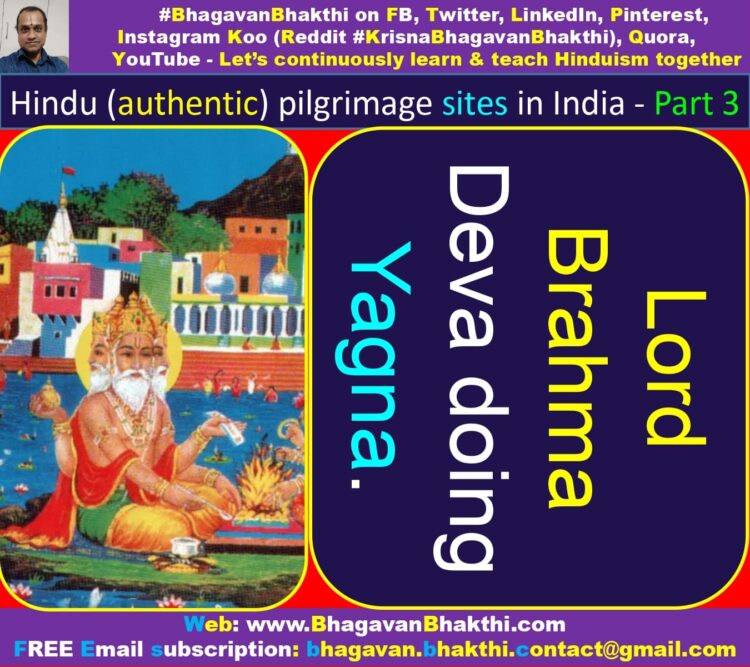
प्रयागमाधवो भूयाद्दयावारिनिधिर्ह्रुदि | प्रकृष्टयागसदृशी सकृद्यस्य हि संस्मृतिः ||
Meaning of the above shloka : May Lord Prayaga Madhava, whose one-time remembrance is itself equal to a great Yagna,
who is the very ocean of compassion, always reside in my heart.
Note : This above shloka is in praise of the Lord Veni Madhava temple at Prayaga (Prayag).
The Mahabharata states that, Lord Brahma performed a yagna at this place.
Hence the place derived the name Prayaga (Prayag).
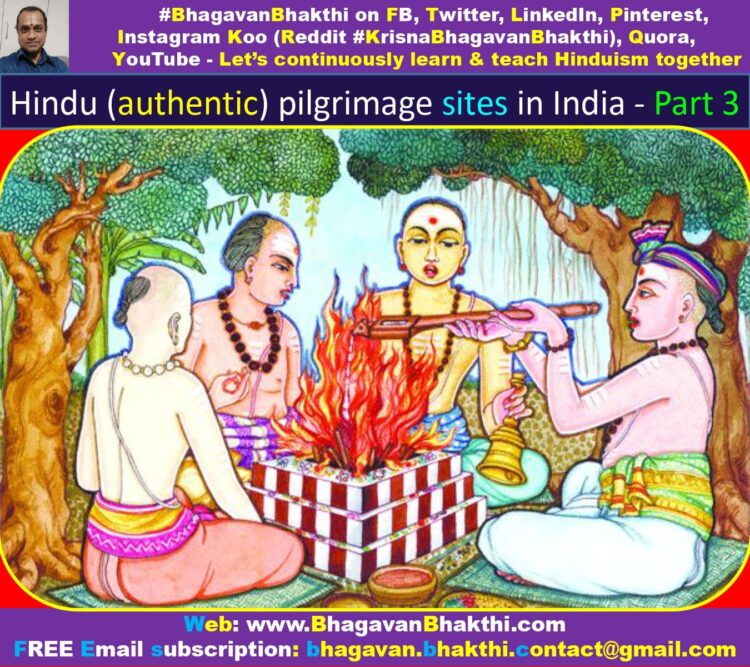
Ganga water : The most holiest river Ganga is the biggest of all rivers in India.
Ganges originates from Gangotri at the Himalayas and after travelling a distance of 2400 kms, merges with today’s Bay of Bengal at Kolkata.
Gangotri is 92 kms away from Uttara Kashi (Uttar Kashi).
Guru Sri Vadiraja Tirtha states that, the color of Yamuna is pink, the color of Saraswati is bluish-black,
and the color of Ganga river is snow-white and it merges at Prayaga (Prayag / Prayagraj).
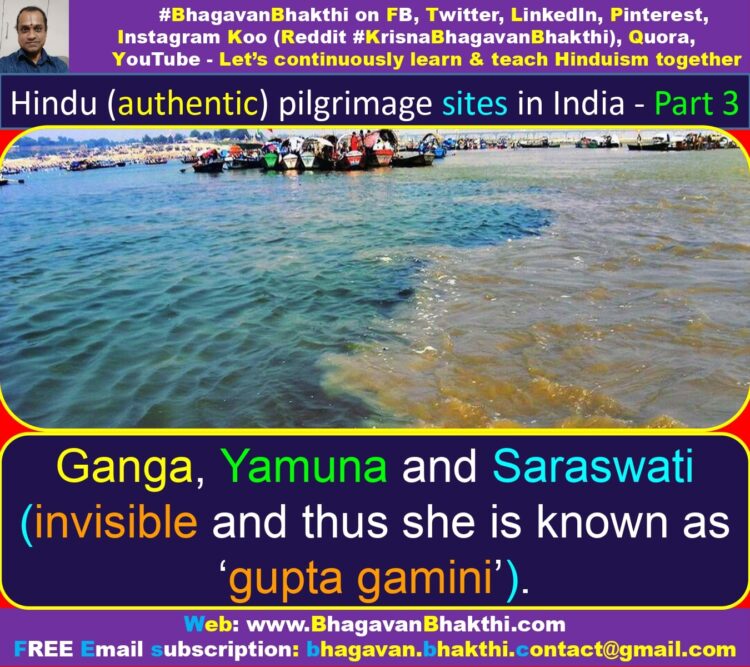
Guru Sri Vadiraja Tirtha also explains that, how Ganga is related to Lord Hari (Vishnu) and how she is special in all the ways.
When Lord vishnu as Lord Trivikrama (Lord Vamana avatar) grew humongous and lifted his foot to measure the upper Lokas as part of the daana from Bali Chakravarti.
Lord Trivikrama’s foot encompassed Satyaloka and the aperture of Brahmanda cracked.
The water which then entered Brahmanda was collected in Lord Brahma’s Kamandala and he then worshipped the feet of Lord Trivikrama (Lord Vishnu).
This same holiest and most auspicious water flow on this earth as river Ganga (Lord Varuna wife).
Subsequently river Ganga then entered ‘Meru hill’ and then Lord Rudra (Shiva) bore it on his head.
Hence Lord Shiva (Rudra) is also known as Lord Gangadhara.
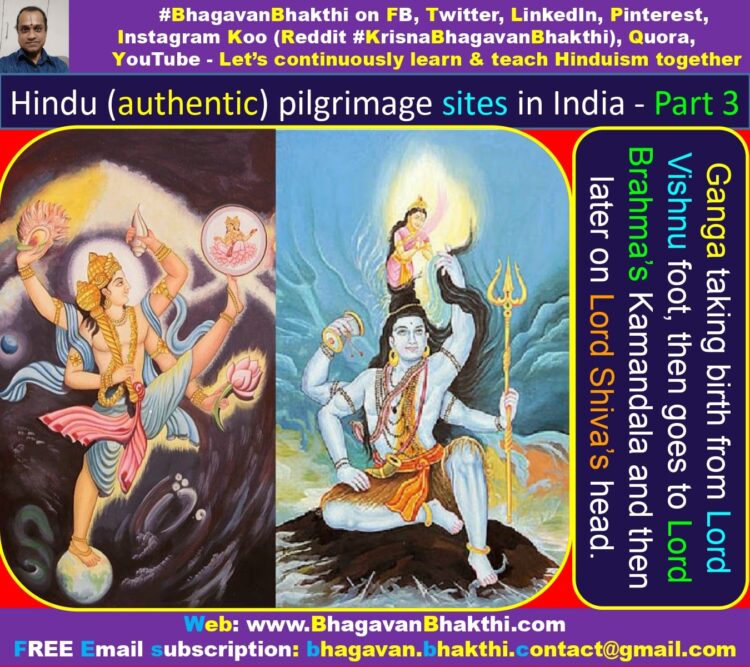
Due to the great penance of the King Bhagiratha, Ganga came down to earth.
Since she also flows in all the three Lokas, that is, Svarga Loka, Bhoo Loka and Patala Loka, she is known as ‘Tripathaga‘ or ‘Tripathagamini‘.
On earth, she originates in Gomukha, about 30 kms from Gangotri, in today’s Uttarakhand.
All the Hindu Puranas and Itihasas sing great praises of this holy river Goddess Ganga Devi.
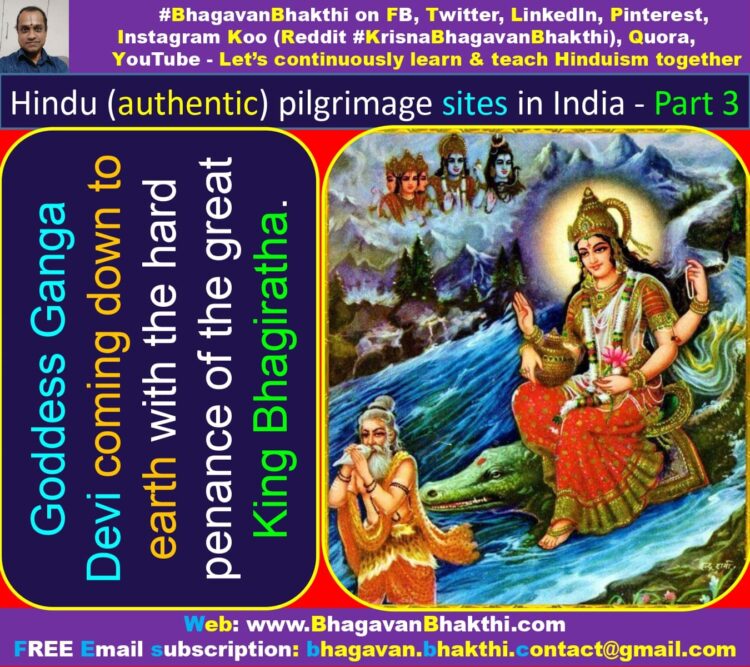
Kashi (Varanasi) (Banaras) Kshetra : Kashi is also known by different names like Varanasi, Vanaras (Banaras).
This divine place Kashi, is well known as the Lord Viswanath’s abode.
Lord Shiva was liberated from ‘Brahma Kapala‘ that stuck to his hand for twelve long years on reaching the Kashi town, that is, the abode of Lord Bindu Madhava (Lord Vishnu).
This happened after Goddess Annapurna Devi gave alms to Lord Shiva and after reaching the abode of Lord Bindu Madhava.
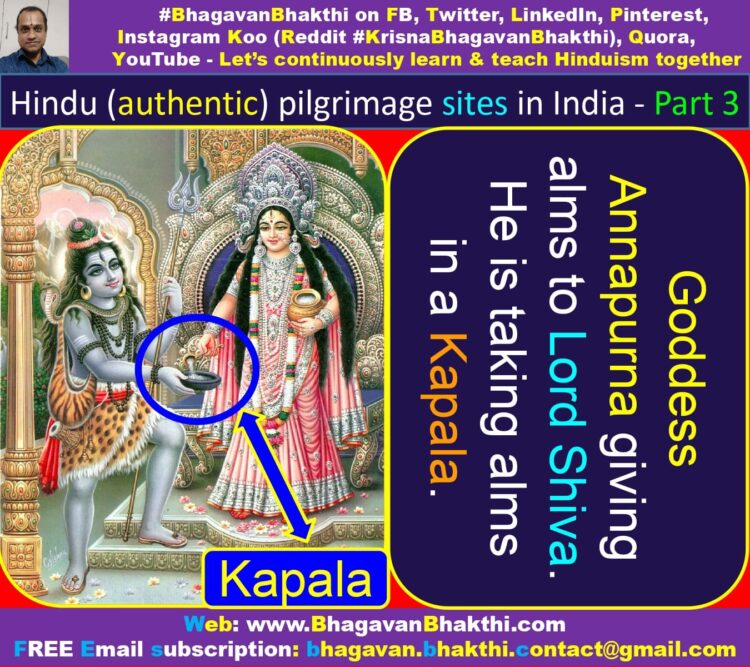
The Kashi Vishweshwar temple as we see it now was built by Ahalya Devi Holkar in 1777 AD.
In 1785 AD, the then King of Kashi, Mansaram and his son Balvant Singh built many more temples near Varanas (Banaras).
Note : Lord Madhava (Vishnu) blessed a rishi called named Bindu in Kashi and thus the deity is known as Lord Bindu Madhava.
Guru Sri Vadiraja Tirtha explains Lord Vishwanath as given below:
Lord Shiva has Lord Chandra on his head and thus he is called as Lord Chandrashekhara (Somashekhara).
Lord Shiva has snakes on his hair and thus he is called as Lord Nagabhushana.
Lord Shiva holds a deer in his hand and thus he is called as Yenapani (येणापाणि).
Lord Shiva has Goddess Ganga on his head and thus he is called as Lord Gangadhara.
Note : In Kashi, Lord Rudra (Shiva) is always walking around chanting the name of Lord Rama.
The divine ‘Srimad Bhagavatam’ declares that Lord Shambhu (Shiva) is the foremost Vaishnava devotee.
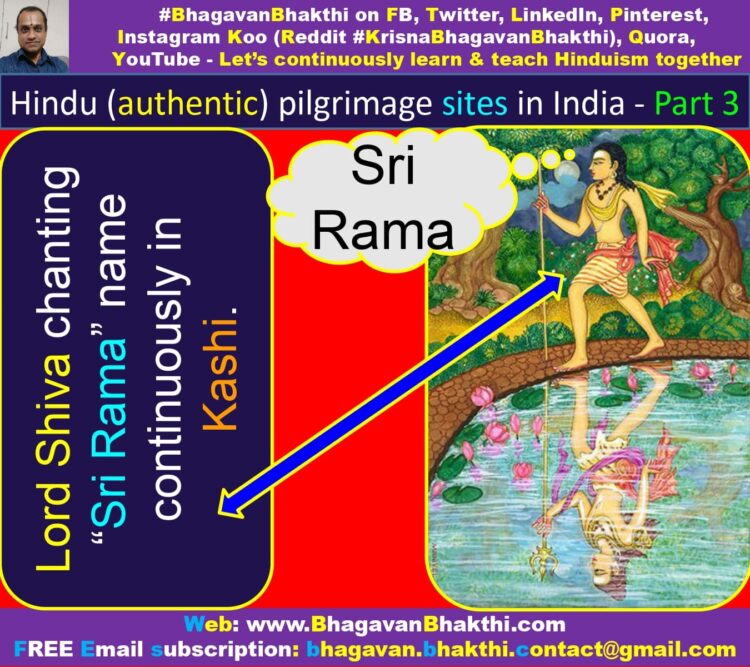
Gaya (Gadadhara) Kshetra : It is situated on the banks of river Phalguni (Phalgu).
It is a belief that doing ‘Pinda Pradhanam‘ here will relieve our departed ancestors from rebirths.
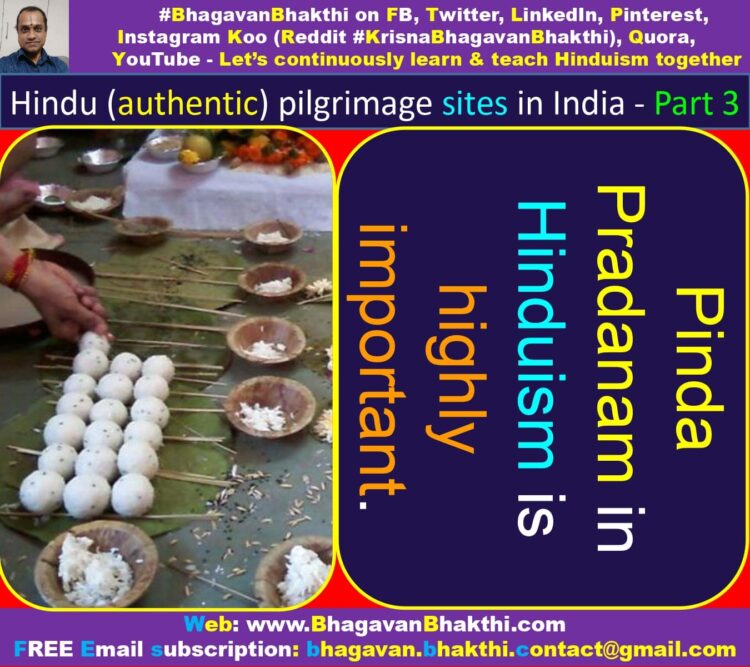
Guru Sri Vadiraja Tirtha describes the significance of Lord Vishnupad (Vishnupada).
The city is named after a demon known as Gayasura. He was a son of Tripurasura.
The history of Gaya is found in the ‘Gaya Mahatmya‘. It is an appendix to the ‘Vayu Purana‘.
And also in a shorter form in the ‘Agni Purana‘ and ‘Garuda Purana‘.
The demon Gaya acquired divine powers, so that anyone who saw or touched him went straight to Svarga Loka (Heaven).
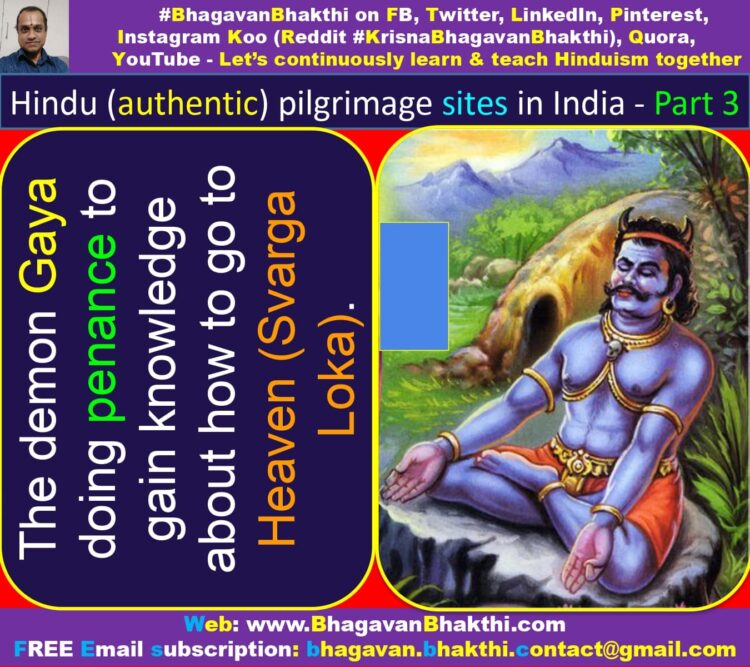
This intruded on the jurisdiction of Lord Yama Deva, who rules Yama Loka.
Lord Vishnu killed the demon after granting him the boon that –
The ground covered by his body, which is ten miles in extent, will become the holiest place on earth and be known as ‘Gaya Kshetra’.
The ancestors of those who perform funeral rituals here, are supposed to be sent straight to higher planets like Svarga Loka.
On behalf of their ancestors, the pilgrims pour water on the temple’s main object of worship,
a stone imprint, 40 cm long and 15 cm wide, of the lotus feet of Lord Vishnu in an octagonal basin, 1.2m in diameter.
The footprint is imprinted in solid rock and is surrounded by a silver-plated basin.
At Gaya, Lord Vishnu resides in the form of ‘Gadadhara’ (holder of Gada / mace).
There is also a Gadadhara temple at this place and hence the name Gaya Gadadhara Kshetra.
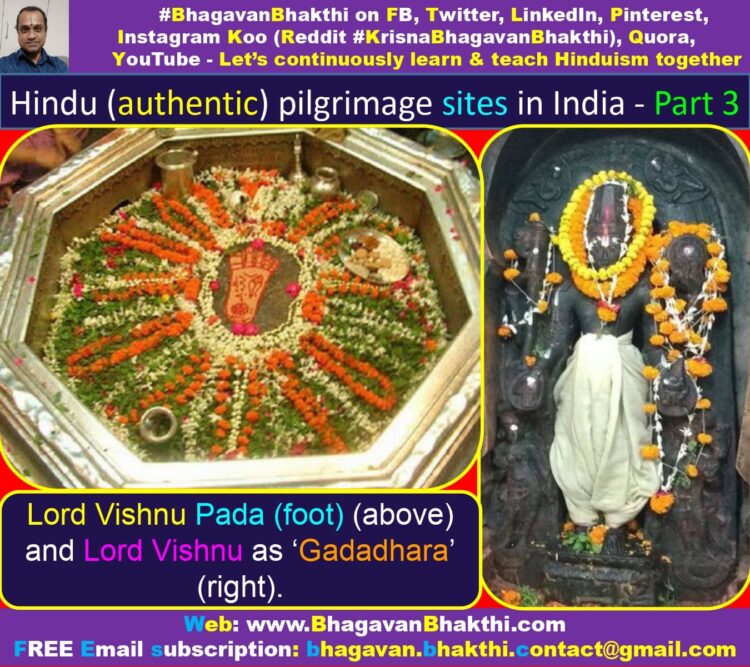
Phalgu (Phalguni) river : This holy river is seen flowing in front of Lord Vishnu Pada (Pad) temple.
The Phalgu river originates from the Kolhala mountains near Gaya.
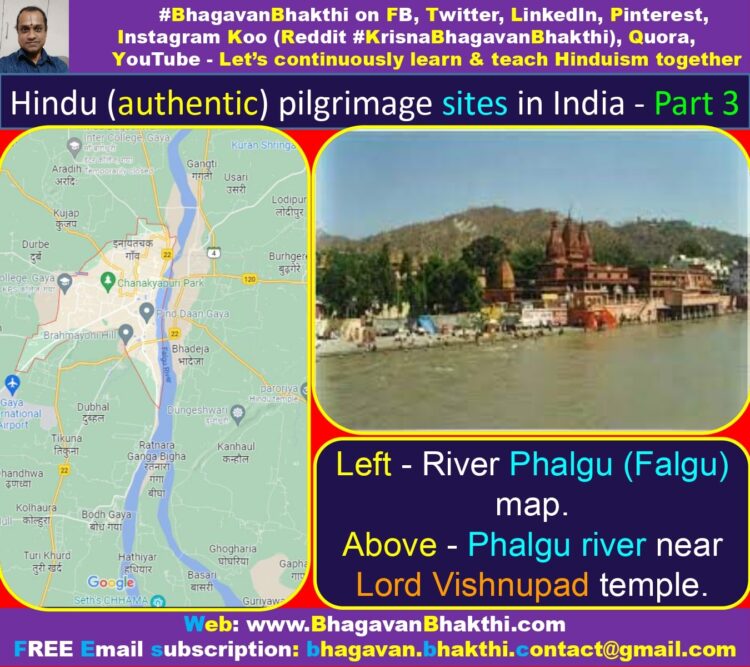
Mathura Kshetra : This revered place called Mathura is a city in the North Indian present state of Uttar Pradesh.
Mathura is located approximately 50 km north of Agra, and 145 km south-east of Delhi
And about 11 kms from the town of Vrindavan and 22 kilometers from Govardhan.
Mathura is the birthplace of Lord Krishna at the centre of Vraj (Braj) or Vrijbhumi (Brijbhumi), called ‘Sri Krishna Janma Bhoomi‘.
This sacred town was constructed by ‘Chathrugna’ during ‘Treta Yuga’, after slaying Lavanasura with an arrow.
Child Dhruva (Dhruv) performed deep penance here for 6 months, before getting the darshan of Lord Sri Vasudeva (Vishnu).
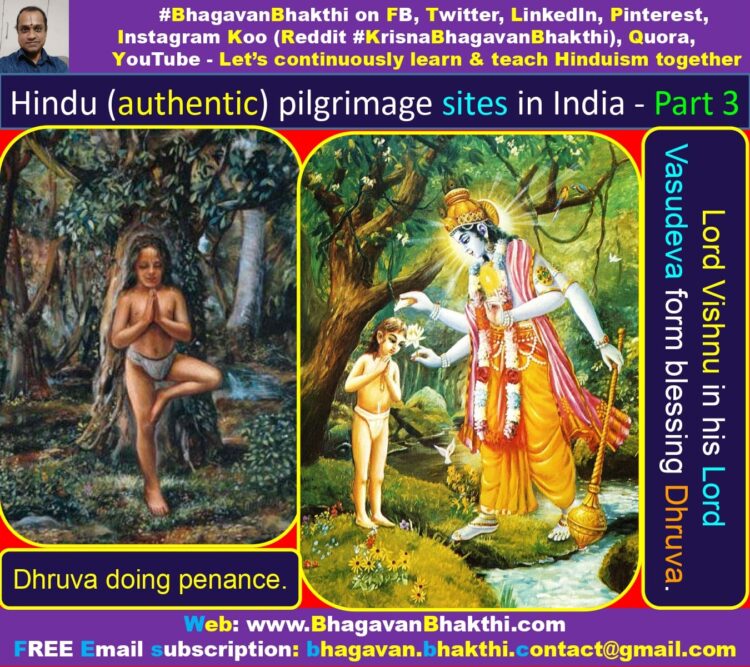
Here, Sri Vishnu Sudarshana Chakra saved the King Ambarisha from the wrath of sage Durvasa (An avatar of Lord Shiva).
Lord Krishna who lifted Govardhana hill for protecting all the Yadavas is just 22 kms away from here.
This Mathura Kshetra in Sanskrit is known as ‘Madhura Kshetra‘ and it is one of the ‘sapta maha kshetras’ of India (Bharata khanda).
It is an extraordinarily important place since it is the avatar place of Lord Krishna.
The city was created after Shatrughna (Lord Rama’s youngest brother) killed a demon called ‘Madhu’ with an arrow given by Lord Rama.
Any ‘satkarma’ (pious works) performed here destroys the effect of Kali (Kali Yuga’s Kali) in our lives and reduces ‘Arishad Vargas‘,
that is, Kama, Krodha, Lobha, Moha, Mada and Matsara.
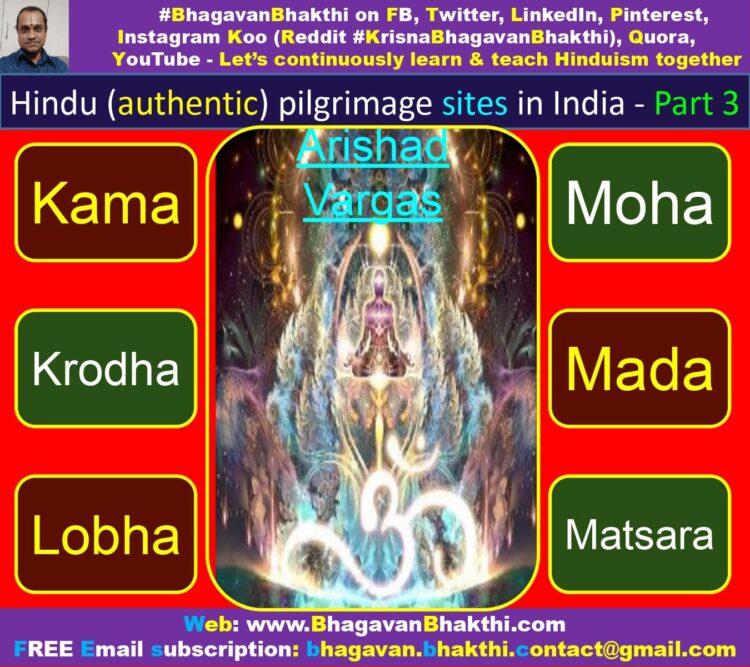
Hence Guru Sri Vadiraja Tirtha highlights the same while explaining the greatness of the divine place.
Vishram Ghat (Vishranti Tirtha) : It is the most revered ghat out of 24 ghats on the banks of River Yamuna.
This place is called as ‘Vishranti Tirtha‘ (Vishram ghat) as Lord Krishna rested here for some time after killing Kamsa.
संसारसंसरणखेदविभेदकारि कंसारिसंश्रिततटीगतचारुवारि | विश्रान्तितीर्थममलं हरिलोकवास विश्रान्तिदं दिशतु नः सकलेप्सितानि ||
Meaning of the above shloka : May the pure Vishranti Tirtha, which makes us free from the pain that accompanies the constant rebirths in sansar (wordly),
which has pleasant water on the banks of which the killer of Kamsa had taken rest,
which grants ‘Vishranti’ (divine rest) by ensuring our stay in the abode of Lord Vishnu (Vaikuntha) grant us all our desires.
Today this place is known as ‘Vishram Ghat‘.
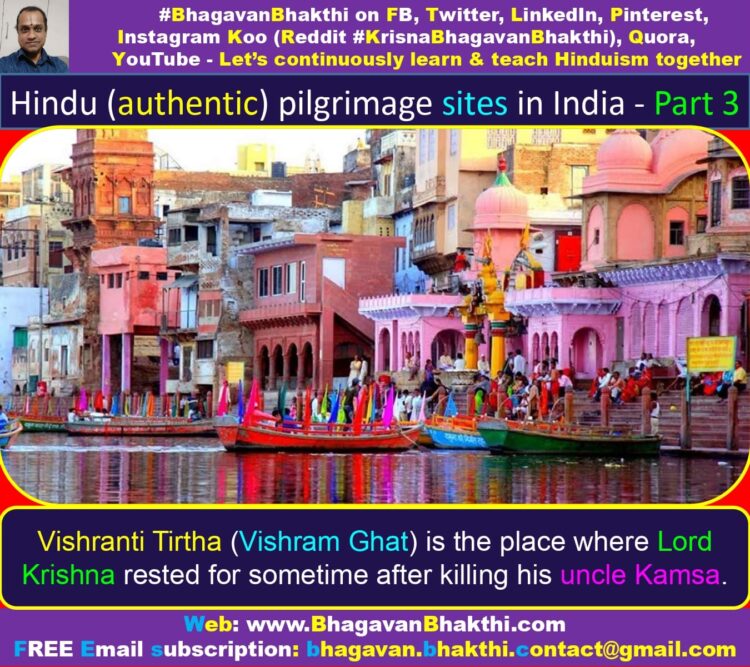
Vrindavan : It is 5 kms away from Mathura.
Lord Krishna spent his early years here and had his ‘Raasa Krida’ (रास क्रीडा) at Vrindavan.
यत्कुञ्जा मुरवैरिसङ्गतवधूविक्रीडनैर्वासिता | यत्सन्जातसुरद्रुमौघमहसा विद्योतिताशामुखम् |
यत्पाथः सुरसिन्धुसिन्धुमहितं यत्राखिलैर्लक्षितं | श्रुत्यन्तान्तरितं महः परमदो वृन्दावनं पावनम् ||
Meaning of the above shloka : The place, where shrubs are emanating fragrance due to the roaming around of the companions of Lord Muravairi (Enemy of Mura, that is Lord Krishna),
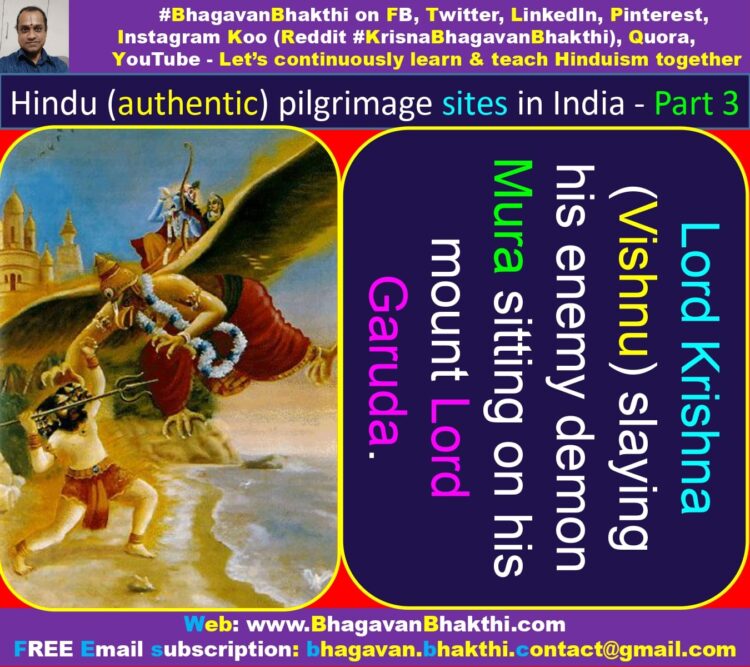
whose directions are all especially radiant due to the radiance emanating from precious flowers and fruits belonging to divine trees that have grown there,
where the water (River Yamuna) is more sacred than the divine river (Ganga) and even the ocean,
where every person sees extraordinary glow of Lord Krishna that cannot be matched by even Vedanta and other shastras – such is the greatness of the place Vrindavan.
Note : Vrindavan is a holy place and this very close to Mathura.
This is the place where Lord Krishna stayed during his childhood and played with the Gopikas.
Vrindavan place obtained its name due to the tapas (penance) performed by a princess known as ‘Vrinda’ and she is the daughter of King Kedara (Kedar).
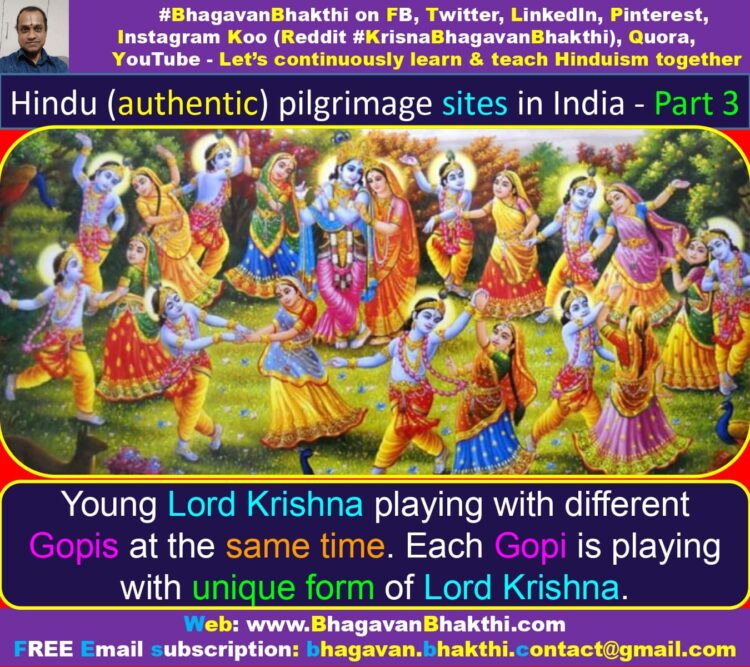
Ayodhya : It is 134 kms away from Lucknow in today’s Uttar Pradesh state.
It is the revered place of Lord Rama of Treta Yuga.
Guru Sri Vadiraja Tirtha explains, how Bharata ruled Ayodhya just with Lord Rama padukas (पादुका).
Note : Ayodhya is the first of the seven ‘Maha Kshetras’ of the India (Bharata khanda).
It is one of the most holiest places for Sanatana Dharmis (Hindus) from time immemorial.
Guru Sri Vadiraja Tirtha visited Ayodhya just immediately after the destruction of the Rama Janmabhoomi temple in C.E 1528.
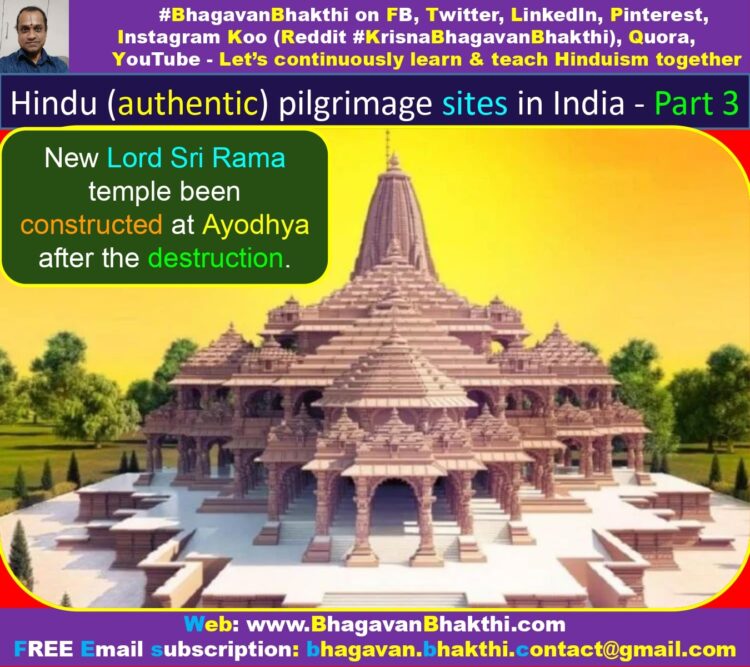
Naimisharanya : This divine and holy place called Naimisharanya is located in the state of today’s Uttar Pradesh.
Naimisharanya is about 90 km from its capital Lucknow in the district of Sitapur.
Naimisharanya is situated on the left bank of the river Gomati, which is a tributary of the river Ganga.
Naimisharanya is popularly known as Neemsar or Naimisha (Naimish).
In the divine Srimad Bhagavatam, it is mentioned like this: naimishe animisha-kshetre (नैमिषे अनिमिष-क्षेत्रे / ನೈಮಿಷೇ ಅನಿಮಿಷ-ಕ್ಷೇತ್ರೇ / naimiṣē animiṣa-kṣētrē).
Naimisharanya is also called as Nemisharanya.
Here ‘Nemi’ means the outer surface of the chakra (disc) and the place where it fell is called by the name of Nemisharanya or popularly called as Naimisharanya.
The spot where the ‘Nemi’ of the chakra fell came to be known as Chakra Tirtha.
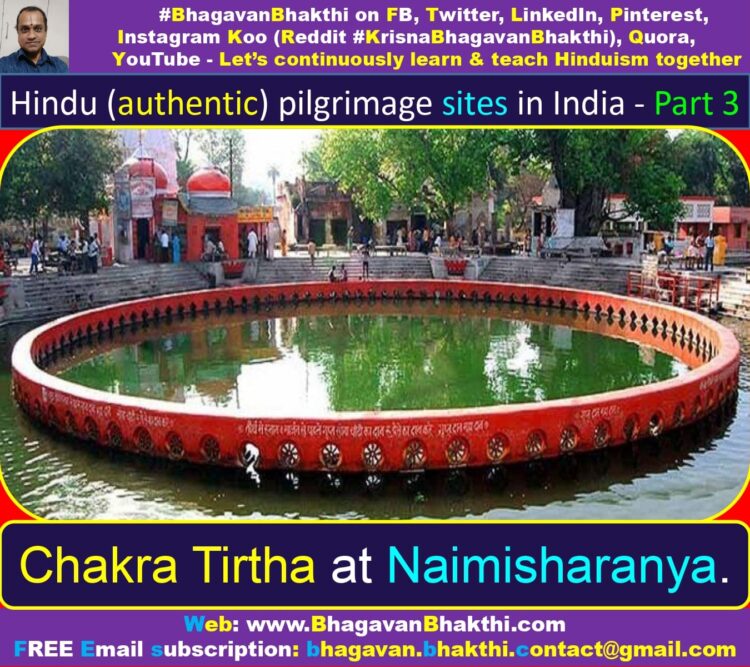
Chakra Tirtha is a sacred bathing place in the shape of a chakra (disc) and the surrounding forest area is called as Naimisharanya.
It is said that, Lord Vishnu had killed demons at this place within a split second, that is, a nimisha (nimisha is a unit of time, the time it takes to blink).
And henceforth this place is called as Naimisharanya.
Note : Naimisharanya is that revered place, where ‘Suta Puranika’ narrated the Srimad Bhagavatam and other Puranas to Shaunaka (Shaunak) and other great Munis (Saints).
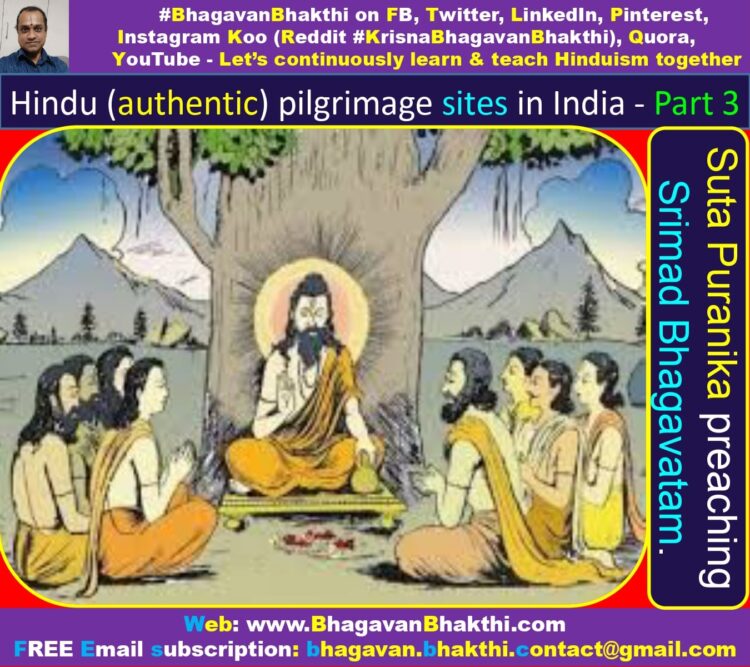
Hastinapura (Hastinapur) : It is about 35 kms South of Meerut in today’s Uttar Pradesh state.
It was the capital of Pandavas for 36 years after Mahabharata (Kurukshetra) war.
Pandavas performed Ashwamedha Yagna here for 15 long years.
Sri Madhwacharya performed one of his chaturmasya vratas in this holy town.
Guru Sri Vadiraja Tirtha, says that, it was chiefly the efforts of Bhima due to which Kali (Kali of Kali Yuga, that is, Duryodhana) was defeated in Hastinapura and dharma was re-established.
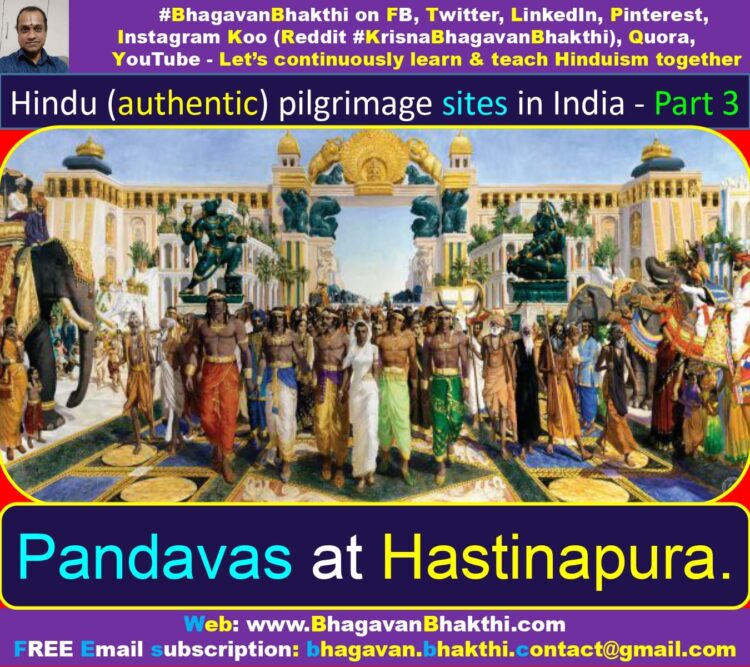
Kurukshetra : The great and highly knowledgeable Rishi Vishwamithra became Maharishi here.
Lord Krishna delivered Bhagavad Gita to the people through Arjuna in this same place.
During grahanas (Solar / Lunar eclipse), Lord Krishna visited this place to have holy bath in Brahma Sarovar.
Sri Madhwacharya visited this place on his way to Badrinath (Badrikashram) and remembered the weapons used by him during his avatar of Bhima during the epic Kurukshetra war.
Due to the achievements of Bhima and Arjuna, the Pandavas won the war and re-established dharma on earth.
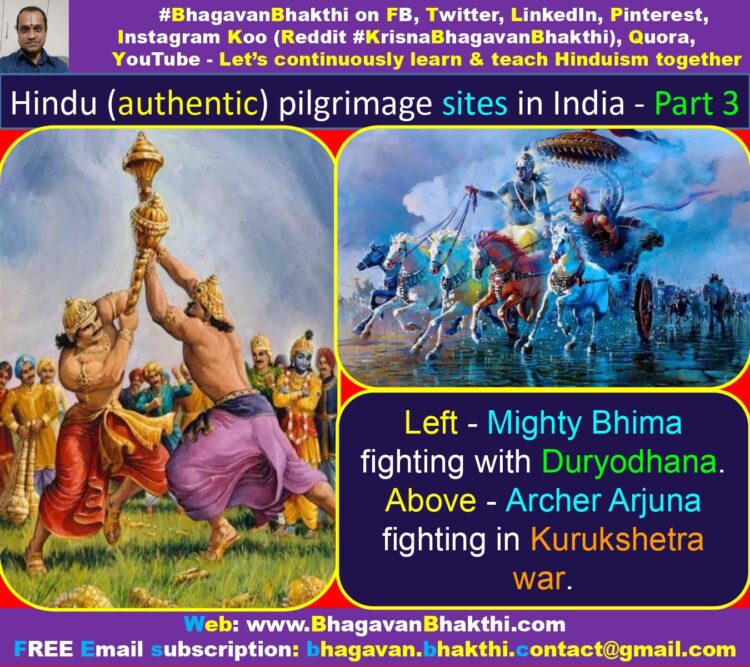
Thus, they also spread the fame of this place.
Vamana Purana narrates that the king of the Kuruvansh (Kuruvamsha), by name Kuru, used two oxen belonging to Lord Rudra and Lord Yama.
And irrigated a field using a golden plough and planted himself as a seed.
Hence the place came to be known as Kurukshetra.
It was in this place that Bhishma rested on the bed of arrows after his fall on the 10th day of the Mahabharata war.
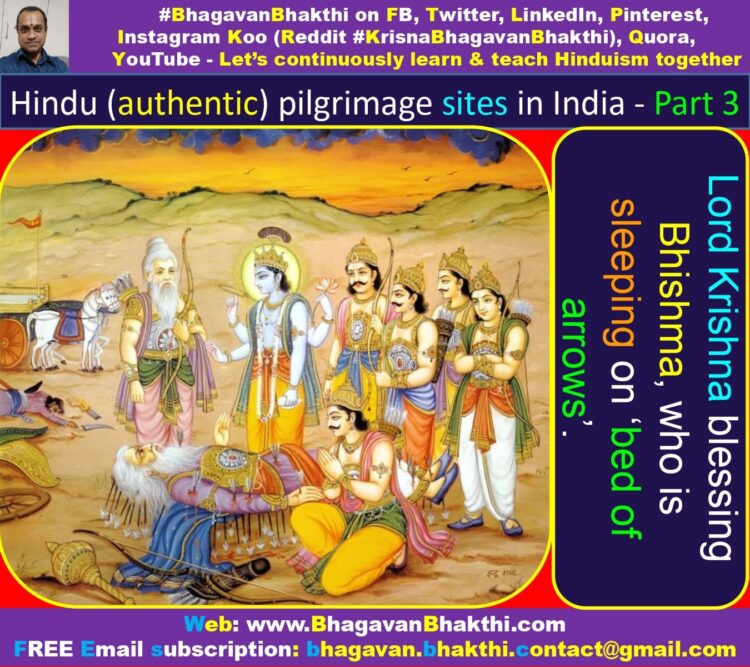
Sambhal (Shambala) Kshetra : It place is situated in Moradabad district of today’s Uttar Pradesh.
The revered town was known as ‘Satyavrata (Satyavrat)’ in Krita Yuga (Satya Yuga), Mahadgiri during Treta Yuga, Pingala in Dwapara Yuga and Shambhala (Sambhal) in Kali Yuga.
Lord Vishnu will take his 10th avatar as Lord Kalki to eradicate evil from this world in this same place of Shambala.
Guru Sri Vadiraja Tirtha indicates that, a yatra (pilgrimage visit) to this place get rid of Kali Yuga’s Kali’s influence.
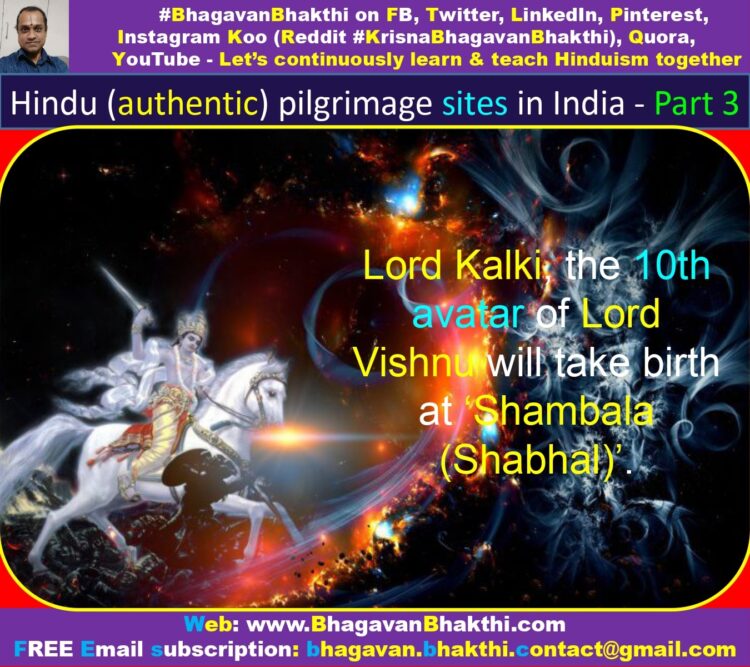
Shat Prayagas : To reach Badrinath dham, one has to cross six Prayagas (Prayags).
The six Prayagas are Deva Prayaga (Prayag), Rudra Prayaga (Prayag), Karna Prayaga (Prayag), Nanda Prayaga (Prayag), Vishnu Prayaga (Prayag) and Keshava Prayaga (Prayag).
The water in all these confluences are always forceful.
And therefore many trees get uprooted and soil is dispossessed.
Guru Sri Vadiraja Tirtha uses the same natural phenomenon to create an allusion on how they rid us of our Shadvairis (6 enemies) and Paapas (sins).
In Sanskrit, Prayaga (Prayag) means confluence of two or more rivers.
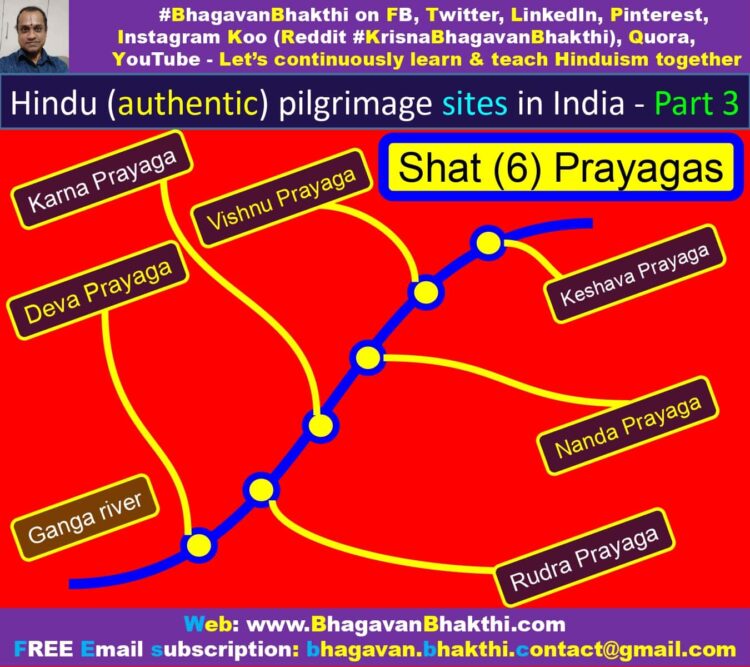
Badari Kshetra (Badrinath) : Lord Vishnu came here in four different avatars as given below –
First one was as Lord Hayagriva from Yagna Kunda,
Second one was as Lord Narayana,
Third one was as Lord Krishna, and
Fourth one was as Lord Vedavyasa.
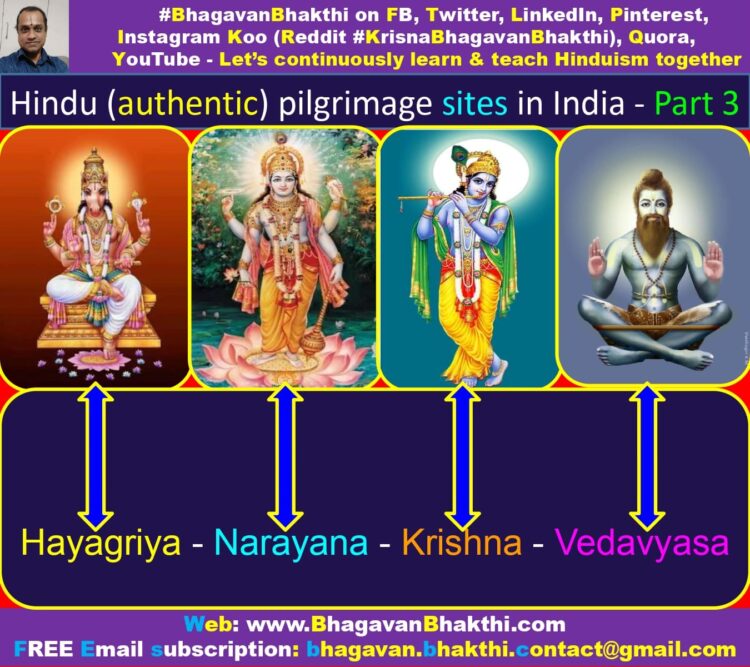
The temple legend says that, the presiding deity measuring about 1 meter is a black stone deity of Lord Vishnu named as Badrinarayan (Badrinarayana).
This deity is considered as one of the eight ‘Swayam Vyakta Kshetras’ (Self manifested).
The saint Sri Madhwacharya wrote ‘Gita Bhasya’ at Badari (Badrinath) and offered the same to Badari Narayana (Badri Narayana).
Badrinath is the spiritual capital of India, as declared by Srimad Bhagavatam.
Badrinath has been mentioned in the Mahabharata, Harivamsha (Harivansh), Srimad Bhagavatam and numerous other itihasas and Purana granthas.
The most sacred river Ganga flows here in the form of Alakananda.
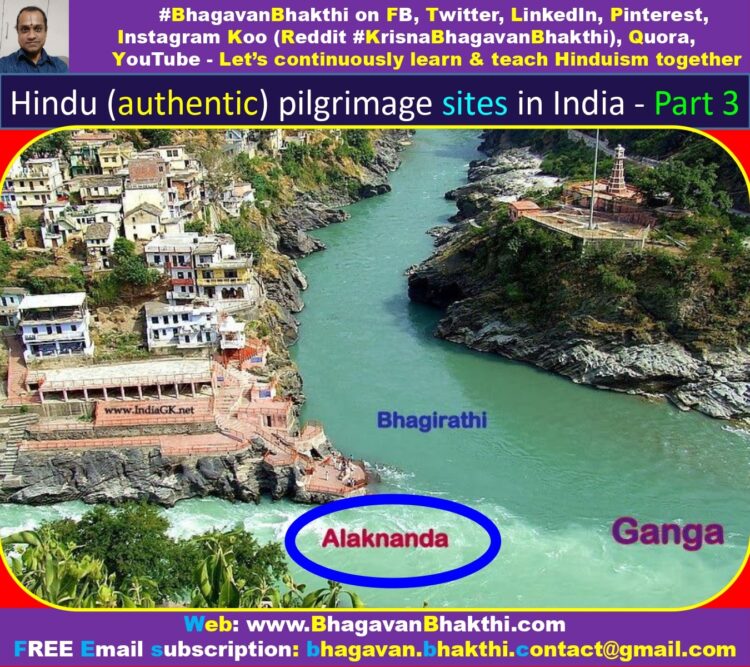
Many puranic kings such as Dhruva (Dhruv), Prithu, Priyavrata and others served Lord Narayana in this very place.
Nara and Narayana, appearing as sons of Lord Yama, performed their penance here.
Urvashi Devi took birth here due to the grace of Lord Narayana.
Lord Krishna granted moksha (divine liberation) to Ghantakarna here.
The great and highly divine Pancha Pandavas took birth here in Badrinath.
Just few kms away from Badrinath, at Keshava Prayag, there is a confluence of rivers Sarasvati and Alakananda.
Nearby there are 2 caves known as Ganesha Guha and Vyasa Guha, where the Mahabharata was composed by Lord VedaVyasa.
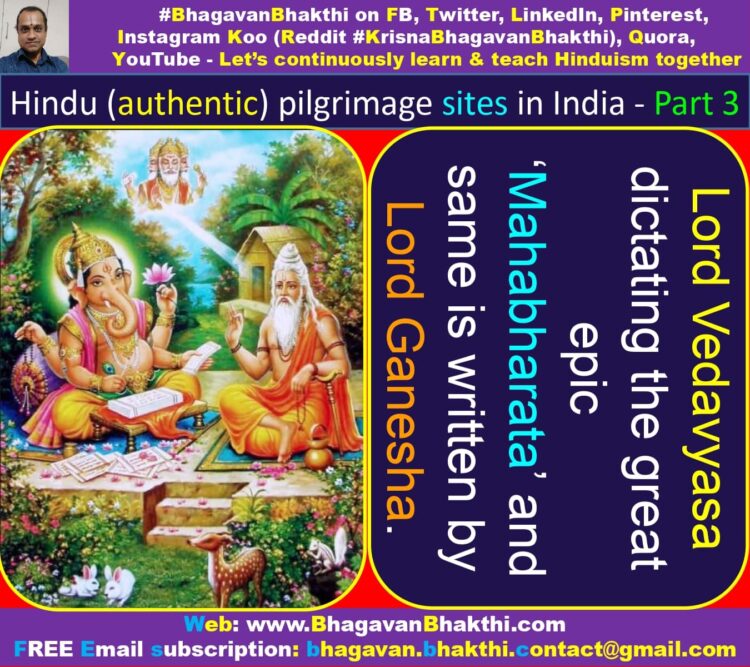
Nearby there are other historical places such as Muchukunda Guha and Bhimasetu which is a bridge created by Bhima during the Mahaprasthana (Finally leaving this world).
In Pandukeshwar, King Pandu spent his time due to the curse of Kindama Rishi.
The Badrinath which is visible to the ordinary humans like us is called as Vishala Badari (Vishal Badri).
There is another Badari (Badri) called as Uttara Badari (Uttar Badri), located further north where Lord Veda Vyasa and Sri Madhwacharya reside even today.
Lord Narayana will always be engaged in yoga in this place of Badrinath.
Lord Narayana has defeated Kaama and other Devatas (Demigods) when they tried to disturb his tapas.
When several Apsaras tried to distract Lord Narayana penance, he created Urvashi Devi from his thigh, the most beautiful amongst all Apsaras to destroy their ego.
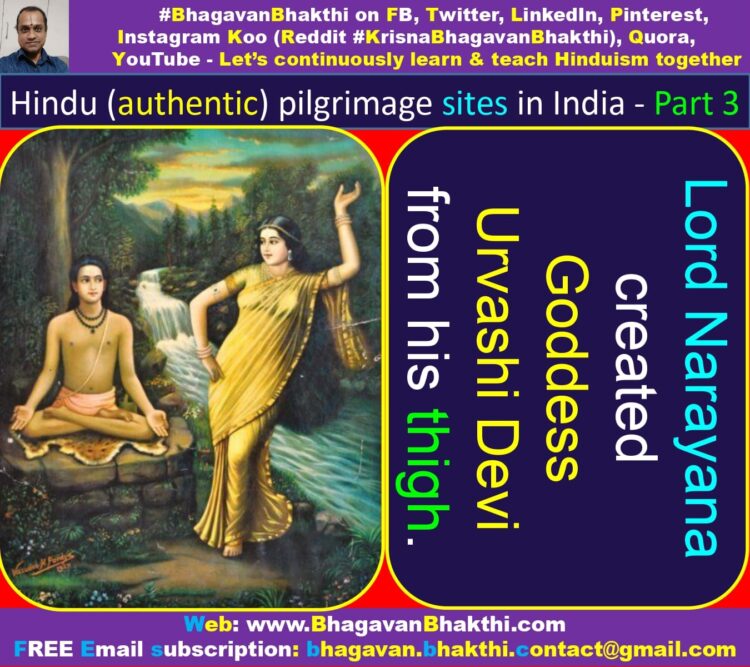
(In Sanskrit Urvashi = Uru + Vashi = Thigh + Born. Thus Urvashi is someone who is born from the thigh of Lord Narayana and hence the name Urvashi.)
Guru Sri Vadiraja Tirtha uses these various incidents to request Lord Badri Narayana for various noble qualities.
Very close to Badrinath place, there is a place called Vasudhaara, where river Alakananda falls down majestically.
Badrinath is the same place where Lord Brahma performed a great yajna during which Lord Hayagriva (Vishnu) made his appearance.
A snana (bath) in this water (Alakananda) gives great knowledge to devotees.
Guru Sri Vadiraja Tirtha during his visit to Badrinath invokes various Devatas (Demigods), to prove that Lord Vishnu is the Supreme amongst all.
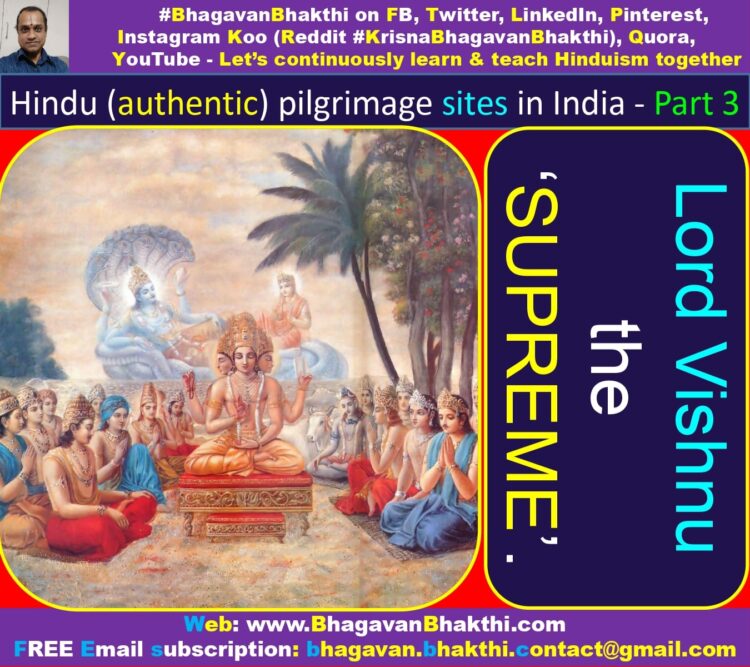
It is also a unique way of refuting various other mathas (mutts), such as Mimamsa, Advaita, Shaiva, Skaanda, Gaanapatya and others, by questioning the presiding deities of those very mathas (mutts).
Lord Brahma had witnessed Lord Vishnu’s greatness during Matsya, Hayagriva and other avatars.
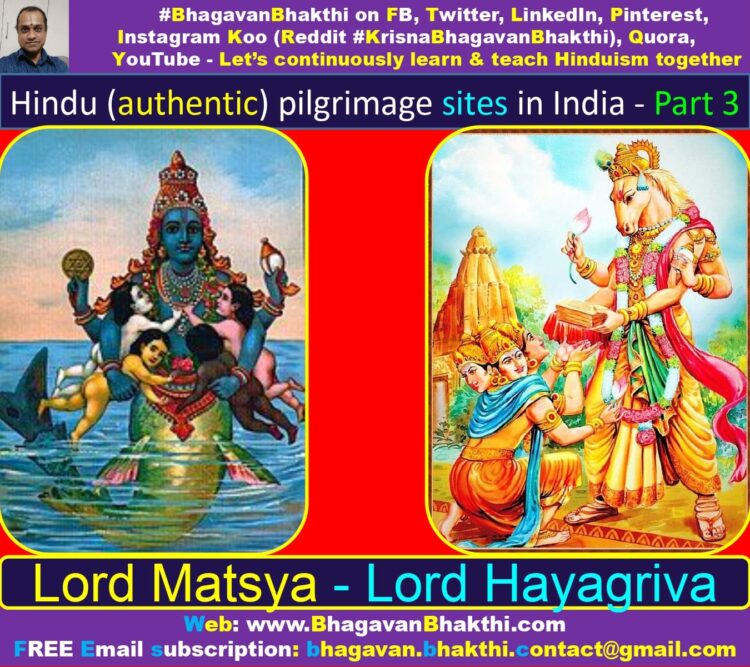
Mandara (Mandar) hill had seen the power of Lord Vishnu during Lord Kurma avatar.
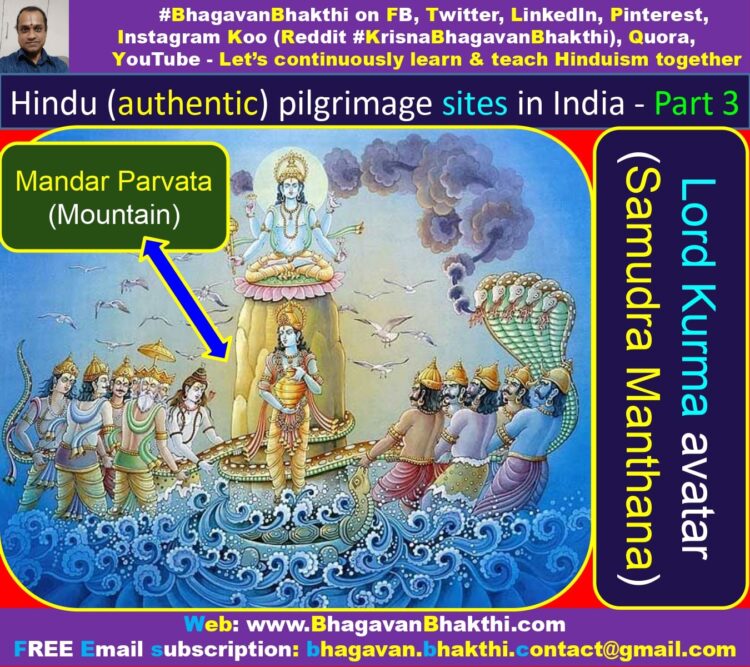
Bhoodevi (Mother Earth) got to know Lord Vishnu’s power during Lord Varaha avatar.
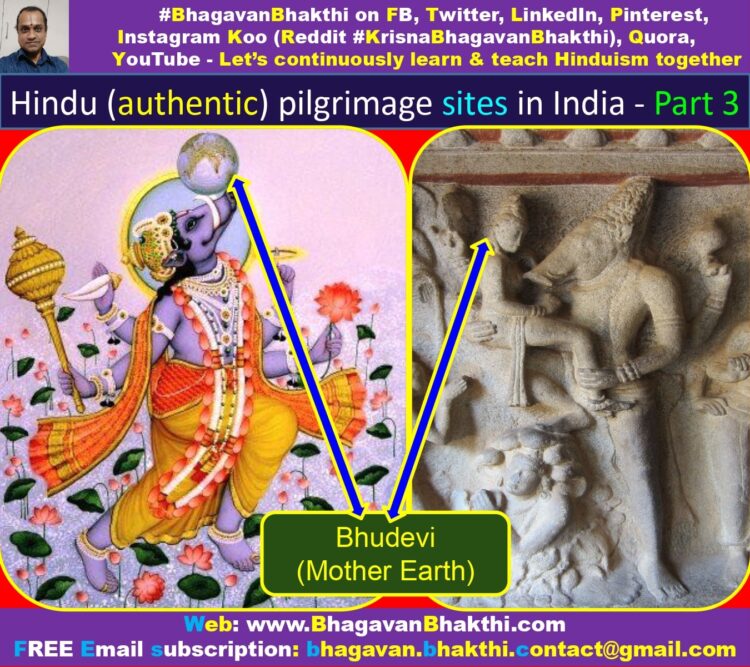
The devotee of Lord Vishnu, that is, Prahlada witnessed Lord Vishnu’s capabilities when he incarnated as Lord Narasimha.
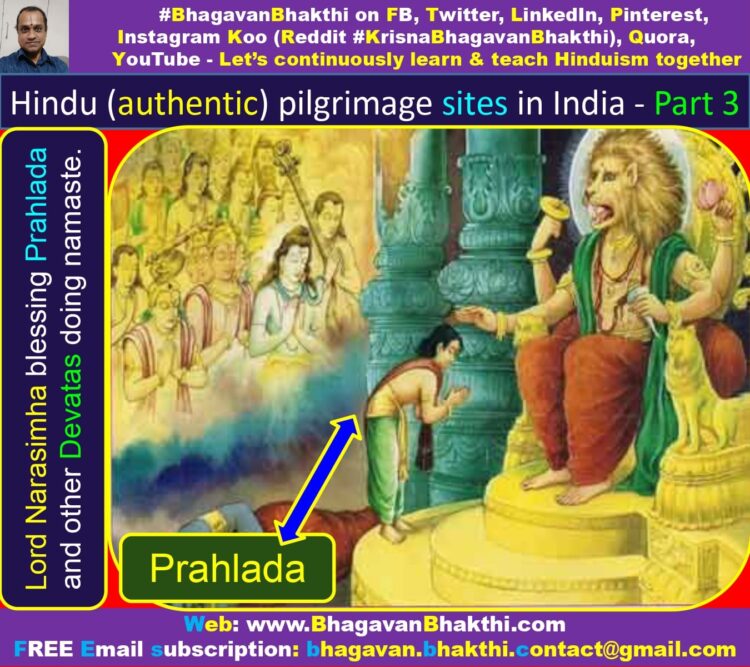
Lord Indra was helped by Lord Vamana. Since Lord Vamana was born as younger of Lord Indra, he was known as Lord Upendra.
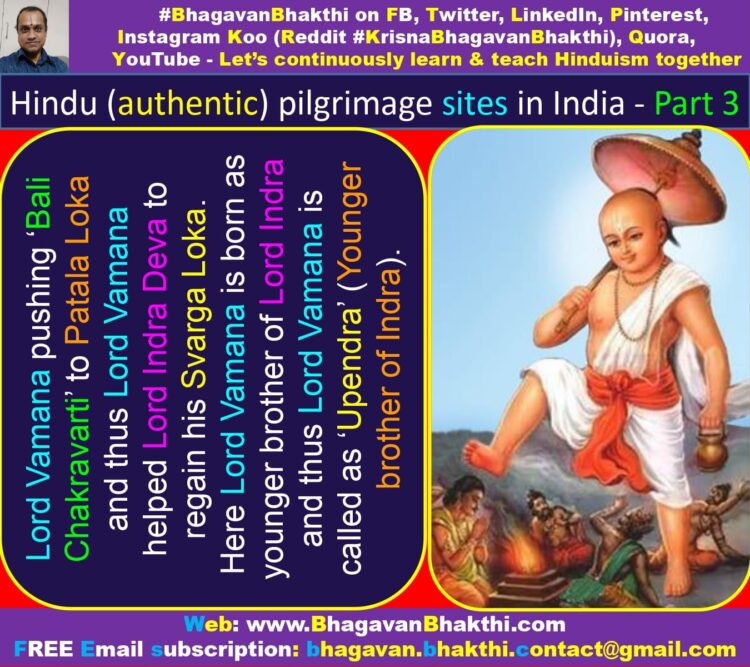
All the divine Brahmanas were saved during Lord Parashurama avatar.
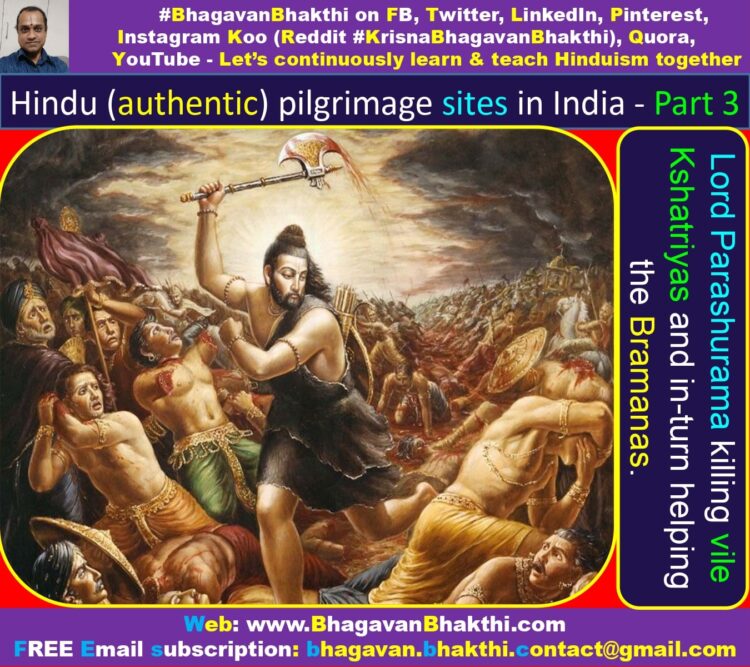
The ocean (Lord Varuna) witnessed Lord Rama’s fury.
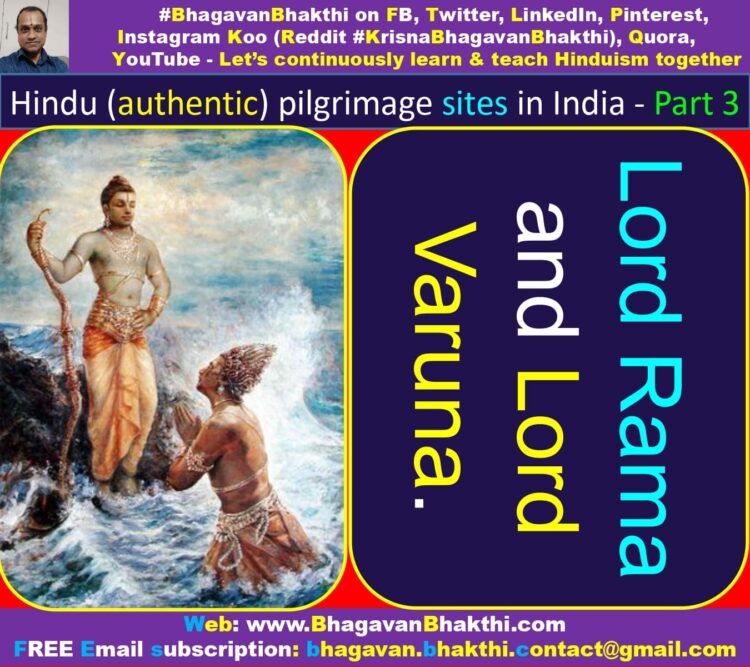
Arjuna got to know Bhagavan personally during Lord Krishna avatar.
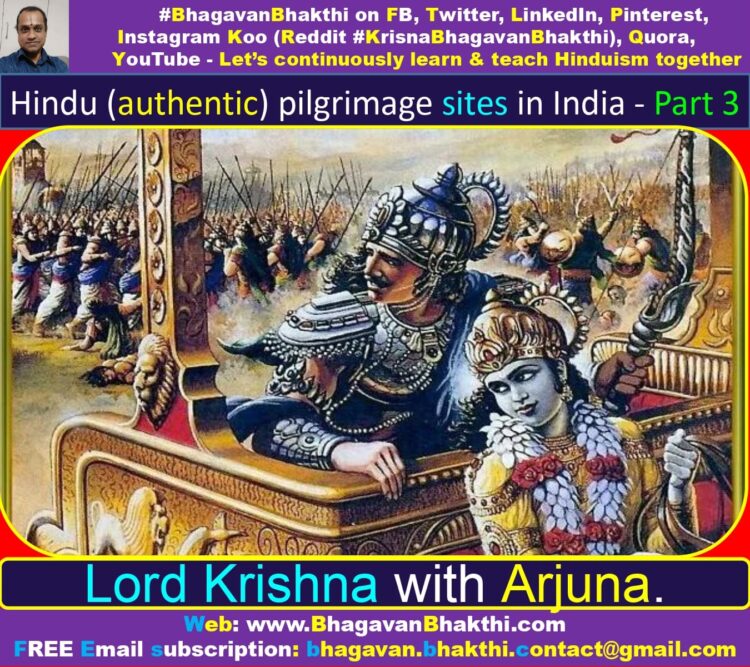
Lord Shiva realized the greatness of Lord Vishnu during Bhasmasura event, that is, yogini and various other incidents.
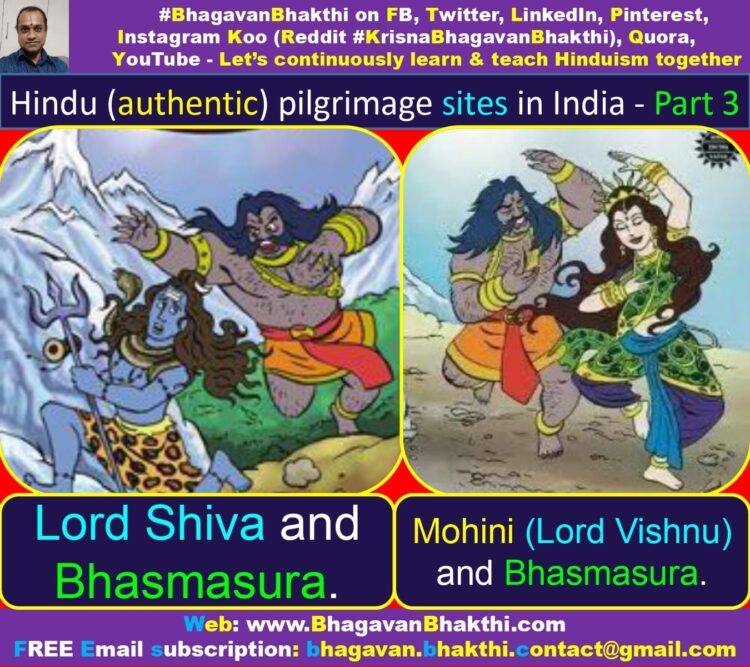
Thus all the people quoted by Guru Sri Vadiraja Tirtha have first hand experienced about the Supremacy of Lord Vishnu.
Note : Guru Sri Vadiraja Tirtha concludes the Uttara Prabandha by paying obeisance to Lord Hayagriva.
To watch videos on #Hinduism #Sanskrit language, SUBSCRIBE to my YouTube channel from this below link:
#BhagavanBhakthi YouTube channel
For “Hindu (authentic) pilgrimage sites in India – Part 1“, please click the below link:
Hindu (authentic) pilgrimage sites in India – Part 1
For “Hindu (authentic) pilgrimage sites in India – Part 2“, please click the below link:
Hindu (authentic) pilgrimage sites in India – Part 2
For “Hindu (authentic) pilgrimage sites in India – Part 4“, please click the below link:
Hindu (authentic) pilgrimage sites in India – Part 4
For “Hindu (authentic) pilgrimage sites in India – Part 5“, please click the below link:
Hindu (authentic) pilgrimage sites in India – Part 5
To know about “Ekadashi unknown facts” and real significances of Ekadashi fasting, kindly click the below link:
To know more about “Lord Krishna unknown facts“, please click the below link:
To know more about “Lord Vishnu unknown facts“, please click the below link:
To know more about “Lord Shiva unknown facts“, please click the below link:
Dear friends, if you need any clarifications about this post, kindly let me know, I will definitely try to answer all of them.
Also your one LIKE, one COMMENT, One Share, one SUBSCRIPTION is highly important.
This will help to know the quality of this content and also it will be helpful to know if any improvements is required for the content.
If you feel this content is useful to you and has helped you to improve your knowledge, kindly share this with your well-wishers.
Because “SHARING MEANS CARING”.
For receive FREE EMAIL SUBSCRIPTION about #BhagavanBhakthi, you can send an email to bhagavan.bhakthi.contact@gmail.com from your email ID.
NAMASTE!
Sri Gurubhyo Namaha
OM NAMO NARAYANAYA
Sri Krishnaarpanamastu
Subscribe / Follow us Share in Social Media
Some truly marvelous work on behalf of the owner of this web site, perfectly great subject matter.
I was very happy to discover this website. I want to to thank you for your time due to this fantastic read!! I definitely liked every little bit of it and i also have you book marked to check out new things on your blog.